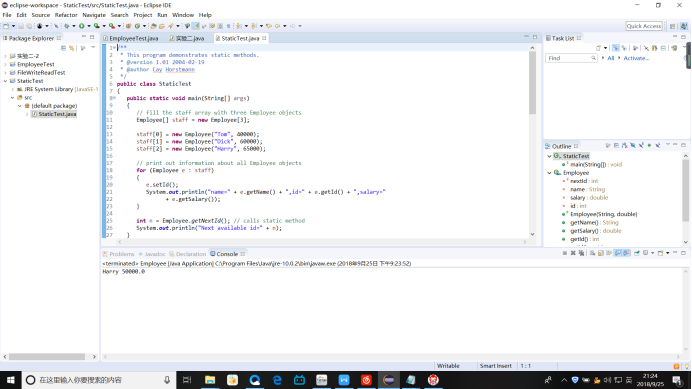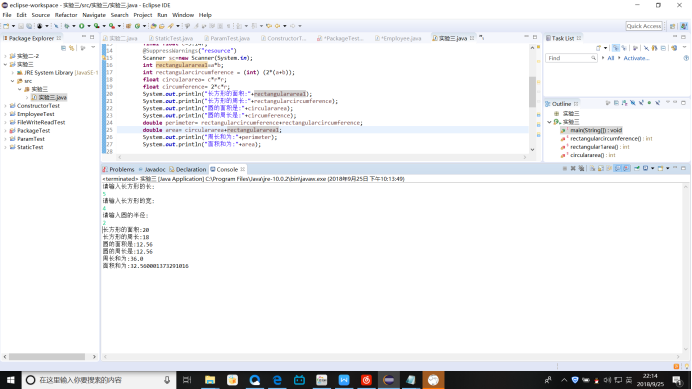张季跃 201771010139《面向对象程序设计(java)》第四周学习总结
第一部分:理论知识学习部分
1、面向对象程序设计:
(1)类:是具有相同属性和行为的一组对象的集合;是构造程序的基本单元。
(2)对象:变成的一个核心概念,未开发计算机应用程序提供技术基础;用来表现现实世界中的实体。
(3)识别类
(4)类之间的关系
2.使用预定义类:
(1)对象与对象变量
(2)Java类库中的LocalDate类
(3)更改器方法与访问器方法
3.用户自定义:
(1)Employee类
(2)多个源文件的使用
(3)从构造器开始
(4)基于类的访问权限
(5)final实力域
4.静态域与静态方法:
(1)静态域
(2)静态常量
(3)静态方法
(4)工厂方法
(5)main方法
5、方法参数
6、对象构造
(1)重载
(2)默认域初始化
(3)显示域初始化
(4)参数名·
(5)调用另一个构造器
(6)初始化块
(7)对象析构与finalize方法
7、包
(1)类的导入
(2)静态导入
(3)将类放入包中
(4)包作用域
8、类路径
(1)设置类路径
9、文档注释
(1)注释的插入
(2)类注释
(4)方法注释
(4)域注释
(5)通用注释
(6)包与概述注释
(7)注释的抽取
10.类设计技巧:
第二部分:实验部分
1、实验目的与要求
(1) 理解用户自定义类的定义;
(2) 掌握对象的声明;
(3) 学会使用构造函数初始化对象;
(4) 使用类属性与方法的使用掌握使用;
(5) 掌握package和import语句的用途。
2、实验内容和步骤
实验1:实验1 测试以下程序,掌握文件输入输出程序设计技术(文件输入输出,教材61-62).
|
import java.io.*; import java.util.*; public class FileWriteReadTest { public static void main(String[] args) throws IOException{ //写入文件演示 PrintWriter out = new PrintWriter("myfile.txt"); out.println("姓名 高数 Java 数据结构 平均成绩 总成绩"); out.println("张三 20 30 40 0 0"); out.println("李四 50 60 70 0 0"); out.close();//输出完毕,需要close //读入文件演示 Scanner in = new Scanner(new File("myfile.txt"));//为myfile.txt这个File创建一个扫描器in int number = 1;//行号 System.out.println(in.nextLine()); while(in.hasNextLine()){//判断扫描器是否还有下一行未读取,该循环把文件的每一行都读出 String line = in.nextLine();//读出myfile.txt的下一行 System.out.print("第"+(++number)+"行的内容: "); Scanner linescanner = new Scanner(line);//行内容建立扫描器 linescanner.useDelimiter(" ");//使用空格作为分隔符 String name = linescanner.next(); String math = linescanner.next(); String java = linescanner.next(); String ds = linescanner.next(); String avg = linescanner.next(); String total = linescanner.next(); System.out.println("name="+name+" math="+math+" java="+java+" ds="+ds+" avg"+avg+" total="+total); } in.close();//读入完毕,最后需要对其进行close。 } } |
实验结果:

实验2 导入第4章示例程序并测试。
测试程序1:
l 编辑、编译、调试运行程序4-2(教材104页);
实验代码:
import java.time.*;
/**
* This program tests the Employee class.
* @version 1.12 2015-05-08
* @author Cay Horstmann
*/
public class EmployeeTest
{
public static void main(String[] args)
{
// fill the staff array with three Employee objects
Employee[] staff = new Employee[3];
staff[0] = new Employee("Carl Cracker", 75000, 1987, 12, 15);
staff[1] = new Employee("Harry Hacker", 50000, 1989, 10, 1);
staff[2] = new Employee("Tony Tester", 40000, 1990, 3, 15);
// raise everyone's salary by 5%
for (Employee e : staff)
e.raiseSalary(5);
// print out information about all Employee objects
for (Employee e : staff)
System.out.println("name=" + e.getName() + ",salary=" + e.getSalary() + ",hireDay="
+ e.getHireDay());
}
}
class Employee
{
private String name;
private double salary;
private LocalDate hireDay;
public Employee(String n, double s, int year, int month, int day)
{
name = n;
salary = s;
hireDay = LocalDate.of(year, month, day);
}
public String getName()
{
return name;
}
public double getSalary()
{
return salary;
}
public LocalDate getHireDay()
{
return hireDay;
}
public void raiseSalary(double byPercent)
{
double raise = salary * byPercent / 100;
salary += raise;
}
}
实验结果:

l 结合程序运行结果,掌握类的定义与类对象的用法,并在程序代码中添加类与对象知识应用的注释;
l 尝试在项目中编辑两个类文件(Employee.java、 EmployeeTest.java ),编译并运行程序。
l 参考教材104页EmployeeTest.java,设计StudentTest.java,定义Student类,包含name(姓名)、sex(性别)、javascore(java成绩)三个字段,编写程序,从键盘输入学生人数,输入学生信息,并按以下表头输出学生信息表:
姓名 性别 java成绩
实验代码:
import java.time.LocalDate;
import java.util.Scanner;
public class 实验二
{
public static void main(String[] args)
{
Employee[] staff = new Employee[4];
System.out.println("请输入学生:");
Scanner in = new Scanner(System.in);
for(int i=0;i<staff.length;i++) {
staff[i]=new Employee(in.next(),in.next(),in.nextInt());
}
System.out.println("name"+" "+"sex"+" "+" "+"javascore");
for (Employee e : staff)
e.raiseSalary(5);
// print out information about all Employee objects
for (Employee e : staff)
System.out.println(e.getName() +" "+e.getSex()+" "+e.getJavascore());
}
}
class Employee
{
private String name;
private String sex;
private int javascore;
public Employee(String a, String b, int c)
{
name = a;
sex = b;
javascore = c;
}
public void raiseSalary(int i) {
// TODO Auto-generated method stub
}
public String getName()
{
return name;
}
public String getSex()
{
return sex;
}
public int getJavascore()
{
return javascore;
}
}
结果验证:

测试程序2:
l 编辑、编译、调试运行程序4-3(教材116);
l 结合程序运行结果,理解程序代码,掌握静态域(netxtId)与静态方法(getNextId)的用法,在相关代码后添加注释;
l 理解Java单元(类)测试的技巧。
实验代码:
/**
* This program demonstrates static methods.
* @version 1.01 2004-02-19
* @author Cay Horstmann
*/
public class StaticTest
{
public static void main(String[] args)
{
// fill the staff array with three Employee objects
Employee[] staff = new Employee[3];
staff[0] = new Employee("Tom", 40000);
staff[1] = new Employee("Dick", 60000);
staff[2] = new Employee("Harry", 65000);
// print out information about all Employee objects
for (Employee e : staff)
{
e.setId();
System.out.println("name=" + e.getName() + ",id=" + e.getId() + ",salary="
+ e.getSalary());
}
int n = Employee.getNextId(); // calls static method
System.out.println("Next available id=" + n);
}
}
class Employee
{
private static int nextId = 1;
private String name;
private double salary;
private int id;
public Employee(String n, double s)
{
name = n;
salary = s;
id = 0;
}
public String getName()
{
return name;
}
public double getSalary()
{
return salary;
}
public int getId()
{
return id;
}
public void setId()
{
id = nextId; // set id to next available id
nextId++;
}
public static int getNextId()
{
return nextId; // returns static field
}
public static void main(String[] args) // unit test
{
Employee e = new Employee("Harry", 50000);
System.out.println(e.getName() + " " + e.getSalary());
}
}
实验结果:

测试程序3:
l 编辑、编译、调试运行程序4-4(教材121);
l 结合程序运行结果,理解程序代码,掌握掌握Java方法参数的用法,在相关代码后添加注释;
测试程序4:
l 编辑、编译、调试运行程序4-5(教材129);
l 结合程序运行结果,理解程序代码,掌握Java用户自定义类的用法,掌握对象构造方法及对象使用方法,在相关代码后添加注释。
测试程序5:
l 编辑、编译、调试运行程序4-6、4-7(教材135);
l 结合程序运行结果,理解程序代码,掌握Java包的定义及用法,在相关代码后添加注释;
实验代码:
/**
* This program demonstrates parameter passing in Java.
* @version 1.00 2000-01-27
* @author Cay Horstmann
*/
public class ParamTest
{
public static void main(String[] args)
{
/*
* Test 1: Methods can't modify numeric parameters
*/
System.out.println("Testing tripleValue:");
double percent = 10;
System.out.println("Before: percent=" + percent);
tripleValue(percent);
System.out.println("After: percent=" + percent);
/*
* Test 2: Methods can change the state of object parameters
*/
System.out.println(" Testing tripleSalary:");
Employee harry = new Employee("Harry", 50000);
System.out.println("Before: salary=" + harry.getSalary());
tripleSalary(harry);
System.out.println("After: salary=" + harry.getSalary());
/*
* Test 3: Methods can't attach new objects to object parameters
*/
System.out.println(" Testing swap:");
Employee a = new Employee("Alice", 70000);
Employee b = new Employee("Bob", 60000);
System.out.println("Before: a=" + a.getName());
System.out.println("Before: b=" + b.getName());
swap(a, b);
System.out.println("After: a=" + a.getName());
System.out.println("After: b=" + b.getName());
}
public static void tripleValue(double x) // doesn't work
{
x = 3 * x;
System.out.println("End of method: x=" + x);
}
public static void tripleSalary(Employee x) // works
{
x.raiseSalary(200);
System.out.println("End of method: salary=" + x.getSalary());
}
public static void swap(Employee x, Employee y)
{
Employee temp = x;
x = y;
y = temp;
System.out.println("End of method: x=" + x.getName());
System.out.println("End of method: y=" + y.getName());
}
}
class Employee // simplified Employee class
{
private String name;
private double salary;
public Employee(String n, double s)
{
name = n;
salary = s;
}
public String getName()
{
return name;
}
public double getSalary()
{
return salary;
}
public void raiseSalary(double byPercent)
{
double raise = salary * byPercent / 100;
salary += raise;
}
}
实验结果:

测试程序4:
l 编辑、编译、调试运行程序4-5(教材129);
l 结合程序运行结果,理解程序代码,掌握Java用户自定义类的用法,掌握对象构造方法及对象使用方法,在相关代码后添加注释。
实验代码;
import java.util.*;
/**
* This program demonstrates object construction.
* @version 1.01 2004-02-19
* @author Cay Horstmann
*/
public class ConstructorTest
{
public static void main(String[] args)
{
// fill the staff array with three Employee objects
Employee[] staff = new Employee[3];
staff[0] = new Employee("Harry", 40000);
staff[1] = new Employee(60000);
staff[2] = new Employee();
// print out information about all Employee objects
for (Employee e : staff)
System.out.println("name=" + e.getName() + ",id=" + e.getId() + ",salary="
+ e.getSalary());
}
}
class Employee
{
private static int nextId;
private int id;
private String name = ""; // instance field initialization
private double salary;
// static initialization block
static
{
Random generator = new Random();
// set nextId to a random number between 0 and 9999
nextId = generator.nextInt(10000);
}
// object initialization block
{
id = nextId;
nextId++;
}
// three overloaded constructors
public Employee(String n, double s)
{
name = n;
salary = s;
}
public Employee(double s)
{
// calls the Employee(String, double) constructor
this("Employee #" + nextId, s);
}
// the default constructor
public Employee()
{
// name initialized to ""--see above
// salary not explicitly set--initialized to 0
// id initialized in initialization block
}
public String getName()
{
return name;
}
public double getSalary()
{
return salary;
}
public int getId()
{
return id;
}
}
实验结果:

测试程序5:
l 编辑、编译、调试运行程序4-6、4-7(教材135);
l 结合程序运行结果,理解程序代码,掌握Java包的定义及用法,在相关代码后添加注释;
实验代码:
import com.horstmann.corejava.*;
// the Employee class is defined in that package
import static java.lang.System.*;
/**
* This program demonstrates the use of packages.
* @version 1.11 2004-02-19
* @author Cay Horstmann
*/
public class PackageTest
{
public static void main(String[] args)
{
// because of the import statement, we don't have to use
// com.horstmann.corejava.Employee here
Employee harry = new Employee("Harry Hacker", 50000, 1989, 10, 1);
harry.raiseSalary(5);
// because of the static import statement, we don't have to use System.out here
out.println("name=" + harry.getName() + ",salary=" + harry.getSalary());
}
}
实验结果:

实验3 编写长方形类Rectangle与圆形类Circle,其中Rectangle类设置私有属性:width,length;Circle类设置私有属性radius。编写Rectangle类的带参构造函数Rectangle(int width,int length), Circle类的带参构造函数Circle(int radius),编写两个类的toString方法(Eclipse可自动生成)。上述2个类均定义以下方法:
求周长的方法public int getPerimeter()
求面积的方法public int getArea()
在main方法中完成以下任务:
(1) 输入1行长与宽,创建一个Rectangle对象;
(2) 输入1行半径,创建一个Circle对象;
(3) 将两个对象的周长加总输出,将两个对象的面积加总输出。
实验代码:
package 实验三;
import java.util.*;
public class 实验三{
public static void main(String[] args) {
Scanner in = new Scanner(System.in);
System.out.println("请输入长方形的长:");
int a=in.nextInt();
System.out.println("请输入长方形的宽:");
int b = in.nextInt();
System.out.println("请输入圆的半径:");
int r = in.nextInt();
final float c=3.14f;
@SuppressWarnings("resource")
Scanner sc=new Scanner(System.in);
int rectangulararea1=a*b;
int rectangularcircumference = (int) (2*(a+b));
float circulararea= c*r*r;
float circumference= 2*c*r;
System.out.println("长方形的面积:"+rectangulararea1);
System.out.println("长方形的周长:"+rectangularcircumference);
System.out.println("圆的面积是:"+circulararea);
System.out.println("圆的周长是:"+circumference);
double perimeter= rectangularcircumference+rectangularcircumference;
double area= circulararea+rectangulararea1;
System.out.println("周长和为:"+perimeter);
System.out.println("面积和为:"+area);
}
private static int rectangularcircumference() {
// TODO Auto-generated method stub
return 0;
}
private static int rectangular1area() {
// TODO Auto-generated method stub
return 0;
}
private static int circulararea() {
// TODO Auto-generated method stub
return 0;
}
}
实验结果:

总结:
在这一周中我学习了第四单元的知识,对Java中的类(如LocalDate类,Employee类Math类、String类、math类等)有了初步的了解,并初步掌握了用户自定义的语法规则如包括实例域、静态域、构造器方法、更改器方法、访问器方法、静态方法、main方法、方法参数的定义要求。
而且在实验中我也对第四单元的操作有了一定的锻炼虽然在实验过程中遇到了很多困难,如对类的掌握不准确,运用类的方法不对等,但这些问题都在请教同学或查找资料后解决了。